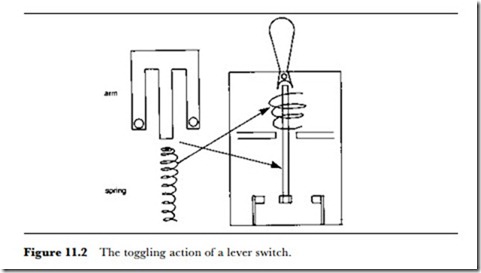Snap-over action
The old-style knife switch had an action for which switching speed depended entirely on the operator, since the moving contact(s) would be mounted on the switch handle that the operator held. Modern switches for supply use do not rely entirely on the movement of the operator to determine opening or closing speeds, so that the switch consists mechanically of two parts, the contact part and the actuating part. Of these, the contact part consists of a spring-loaded toggle (Figure ll.2) which has two stable positions (the positions in which contact is made). In any other position of the toggle, apart from a precariously balanced central position, the spring action will ensure that the moving contact is in one stable position or the other. This spring also determines the force with which the contacts are held together.
The actuating portion of the switch will, in its motion, displace part of the spring toggle until the spring action flips over the switch. In this way the shape of the toggle and the strength of the spring determine the minimum switching time. No matter how slowly the switch is actuated, the toggle action should ensure that the moving contact snaps over, and no normal style of actuation should allow the moving contact to rest in any position
except its contact (or onjoff) states. The action of the operator can, however, affect the switching time in the sense that fast operation can speed up switching. Note that the action of a biased switch (see below) is very much more directly affected by the operator.
The actuator of the switch does not affect the static contact pressure, but very fast actuation can greatly increase the dynamic pressure, i.e., the momentary pressure due to the momentum of the moving contact assembly. This can in turn lead to excessive switch bounce, in which the contacts close and then bounce open again before closing finally. Switch bounce is more of a hazard for signal-carrying switches, but it can cause increased severity of arcing in non-signal switches, and the excessive mechanical force that accompanies it can also shorten the life of a switch.
